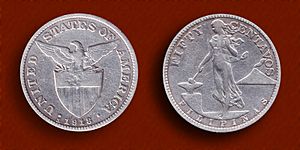Melecio Figueroa facts for kids
Quick facts for kids
Melecio Figueroa
|
|
|---|---|
| Born | May 24, 1842 Arevalo, Iloilo, Captaincy General of the Philippines
|
| Died | July 30, 1903 (aged 61) |
| Resting place | Paco, Manila, Philippines |
| Nationality | Filipino |
| Alma mater | Escuela de Artes y Officios Real Academia de Bellas Artes de San Fernando |
Melecio Figueroa (Tagalog pronunciation: [fɪɡɛˈɾoʊa]) was a talented Filipino artist. He was a sculptor (someone who makes art by shaping materials) and an engraver (someone who carves designs onto surfaces, like metal). His amazing designs were even used on many Philippine peso coins for a long time!
Contents
Early Life and Learning
Melecio Figueroa was born on May 24, 1842. His hometown was Arevalo, in Iloilo, Philippines. His parents were Gabriela Magbanua and Rufo Figueroa.
When Melecio was very young, his mother passed away. He and his sister then went to live with relatives in Sorsogon. These relatives sold cakes for a living. Even as a child, Melecio loved to create. He would carve small wooden boats and dolls. He often gave these handmade toys to his friends.
Studying in Spain
When Melecio was 16, he got a big chance. The city government of Manila chose him as one of two Filipino artists. They would receive a special scholarship to study in Spain. This scholarship was sponsored by Francisco Ahujas, a consul in the Philippines.
Melecio arrived in Madrid, Spain, in 1866. He first enrolled at the Escuela de Artes y Officios. Later, he moved to the famous Real Academia de Bellas Artes de San Fernando. This was a very important art school.
Sadly, his sponsor, Ahujas, passed away. To support himself, Melecio started repairing watches in Madrid. While he was studying in Spain, he won many awards. He received recognition for his amazing engraving skills.
Career and Contributions
In 1892, Melecio Figueroa returned to the Philippines. He became a professor at the Escuela de Pintura, Escultura y Grabado in Manila. There, he taught engraving to new students.
The next year, in 1893, he got an important job. He was appointed as an engraver at the Casa Moneda. This was the colonial mint, where coins were made. Besides his official work, Figueroa also kept repairing watches. He even opened his own silversmith shop in Manila.
Melecio Figueroa was also involved in important historical events. He was a delegate (a representative) at the Malolos Congress in 1898. This was a very important meeting where the First Philippine Republic was formed. He also taught at the Liceo de Manila until he passed away in 1903.
Famous Artworks and Designs
Melecio Figueroa created many notable works. In 1875, he made a bust (a sculpture of a head and shoulders) of Alfonso XII. This artwork was shown at the Exposicion de Bellas Artes. His work was highly praised, and he was given a pension (a regular payment).
While he was in Rome, he created another bust. This one was of Prinsipe d’Odellaski. In 1887, he served as a judge at the Exposicion de Filipinas in Madrid. He also designed the medals given out at this event.
In 1903, Figueroa entered a competition. It was to design the new Philippine peso coinage system. His design was chosen as the winner! This coin series was called the Conant series. It was named after Charles A. Conant. Figueroa's designs were used on Philippine peso coins for a long time, even until the 1960s.
His design was so good that it was also used for something else. It became part of the Great Seal of the U.S. government in the Philippines. This seal was used from 1903 to 1905.
Later Years
Melecio Figueroa passed away on July 30, 1903. He died from tuberculosis, a serious illness. He was buried in Paco, Manila.
See also
 In Spanish: Melesio Figueroa para niños
In Spanish: Melesio Figueroa para niños


